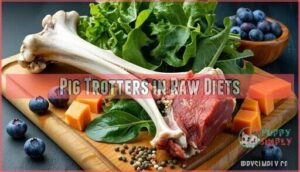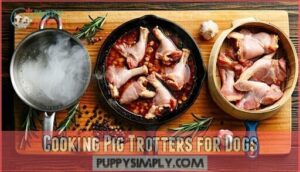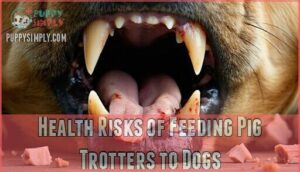This site is supported by our readers. We may earn a commission, at no cost to you, if you purchase through links.

These bony treats pack plenty of joint-supporting nutrients like collagen and glucosamine, making them a natural health boost for your furry friend.
However, pig feet aren’t one-size-fits-all – aggressive chewers might splinter the bones, while dogs with sensitive stomachs could face digestive issues from the rich fat content.
You’ll want to choose the right size for your dog’s breed and introduce them slowly to test tolerance, which allows for smart preparation and supervision to turn these traditional treats into safe, beneficial chewing sessions.
Table Of Contents
- Key Takeaways
- What is a Pig Trotter?
- Benefits of Pig Trotters for Dogs
- Feeding Pig Trotters to Dogs
- Are Pig Trotters Safe?
- How to Feed Pig Trotters to Dogs
- Where to Buy Pig Trotters for Dogs
- Health Risks of Feeding Pig Trotters to Dogs
- Are Pig Trotters Good for Dogs?
- Frequently Asked Questions (FAQs)
- Are raw pig feet good for dogs?
- Can dogs eat pig feet?
- Should you eat pig’s feet?
- Are smoked pig feet bad for dogs?
- Why do dogs eat pig feet bones?
- What happens if a dog eats dehydrated pig feet?
- Is it safe for dogs to eat pig feet?
- How do you prepare pig’s feet for dogs?
- Are pig hooves safe for dogs?
- Is pig feet broth good for dogs?
- Conclusion
Key Takeaways
- You can feed your dog pig feet as an occasional treat, but you’ll need to supervise them closely – these bony treats provide joint-supporting nutrients like collagen and glucosamine, but they’re not suitable for all dogs due to splintering risks and high fat content.
- Choose raw pig feet over cooked ones to avoid dangerous bone splintering – cooked bones become brittle and can cause choking hazards or internal injuries, while raw pig feet maintain their structural integrity and offer better nutritional value.
- Size matters when selecting pig feet for your dog – medium to large dogs handle these treats better than smaller breeds, and you’ll want to match the size to your dog’s chewing habits to prevent choking risks.
- Introduce pig feet gradually and limit portions to prevent digestive issues – the high fat content can trigger pancreatitis, especially in smaller dogs, so start slowly and keep these treats to no more than 10% of your dog’s total diet.
What is a Pig Trotter?
Understanding pig trotters starts with knowing exactly what you’re giving your dog.
Pig feet, also called pork trotters, are the lower portions of a pig’s leg that include bones, cartilage, skin, and meat.
These cuts contain dense bone structure surrounded by connective tissue rich in collagen. From a trotter anatomy perspective, each foot consists of multiple small bones held together by tough ligaments and tendons.
The pig foot cuts you’ll find at butcher shops or pet stores typically include the entire hoof and ankle joint. Unlike culinary uses in human cuisine where they’re often slow-cooked for stews, raw pig feet serve as natural chew toys for dogs.
Global variations exist in how these are processed, but for canine diet purposes, you want fresh, unprocessed trotters. The nutritional differences between raw and cooked versions are significant – raw maintains bone integrity while cooked bones become dangerous splinters.
These additions to dog nutrition should always be sourced from reputable suppliers. To guarantee proper dog health and nutrition, consult with your veterinarian.
Benefits of Pig Trotters for Dogs
Pig trotters pack a nutritional punch that’ll make your dog’s tail wag with good reason.
These natural chews deliver impressive joint support through collagen, glucosamine, and chondroitin – keeping your pup’s joints healthy and mobile.
They’re also an excellent nutrient source, loaded with protein, iron, zinc, and vitamin B12.
Here’s what makes pig feet benefits shine:
- Dental Health – Natural teeth cleaning that fights tartar buildup
- Mental Stimulation – Hours of engaging chewing satisfaction
- Joint Support – Essential nutrients for cartilage and bone health
Feeding Pig Trotters to Dogs
When you’re ready to give your dog pig trotters, you’ll need to take into account your pet’s size, chewing habits, and overall health first.
These bony treats work best for medium to large dogs who can handle the size and density without choking or breaking their teeth, making them a suitable option for pets with specific chewing habits.
Types of Dogs Pig Trotters Are Best For
Age consideration plays a vital role when determining if pig feet suit your furry friend.
Dogs of all ages can safely enjoy these treats, from four-week-old puppies to senior companions.
Breed size matters most—medium to large dogs handle pig feet better than smaller breeds due to choking risks.
Your dog’s chewing style and activity level also influence safety.
Active dogs benefit from the mental stimulation, while gentle chewers can focus on dental health improvements.
Consider your pet’s dietary needs, as pig feet for dogs provide excellent protein but require moderation for ideal dog health.
How Much Bone is in Pig Trotters?
Bone density makes pig trotters virtually pure bone – they’re 100% bone with minimal meat content.
This high bone percentage means you’re giving your dog a concentrated calcium source that requires careful portion control.
The trotter composition includes at least 40% crude protein and 28% crude fat, making bone digestibility a key consideration for your pup’s system.
- Bone-to-meat ratio: Nearly all bone with trace meat
- Pig feet for dogs: Best for strong chewers only
- Are pig feet safe: Yes, when properly sized and supervised
- Pig feet risks: Choking hazards for smaller breeds
Are Pig Trotters Safe?
Several safety concerns surround pig feet for dogs, making careful consideration essential.
While pig trotters offer benefits, proceed with caution—your dog’s safety depends on proper preparation and supervision.
Bone splintering poses serious risks, especially with cooked bones that can cause choking hazards or internal injuries.
The high fat content can trigger pancreatitis, particularly in smaller breeds.
Some dogs experience allergic reactions to pork products.
Bacterial contamination from raw pig feet may introduce harmful pathogens like Salmonella.
Cooking safety becomes vital since improperly prepared pig feet increase health risks.
While pig feet offer benefits, these potential dangers require careful evaluation before adding them to your dog’s diet, considering factors like bone splintering and bacterial contamination.
How to Feed Pig Trotters to Dogs
When you’re ready to offer pig trotters to your dog, the preparation method makes all the difference between a safe treat and a potential health hazard.
You’ll need to choose between raw and cooked options, with each approach requiring specific steps to keep your furry friend healthy and happy.
Pig Trotters in Raw Diets
When incorporating pig feet into your dog’s raw feeding routine, you’re providing a nutrient-dense addition that supports canine nutrition goals.
Raw pig feet offer superior Raw Trotter Nutrients compared to processed alternatives, with excellent Trotter Digestibility when sourced properly.
Focus on Trotter Sourcing from reputable suppliers to guarantee quality and safety. The Trotter Bone Content provides natural dental benefits while supporting Raw Diet Balance.
To promote healthy growth, consider that nutrient-rich raw diets are beneficial for puppies.
These raw meaty bones should comprise no more than 10% of your dog’s total diet to maintain proper nutritional proportions and prevent digestive upset.
Cooking Pig Trotters for Dogs
Cooking pig feet changes their nutritional profile and safety for your dog.
While raw versions offer maximum nutrients, cooked pig feet lose some vitamins during preparation but become easier to digest. However, cooking makes bones brittle and dangerous, requiring complete removal before serving.
Here are three essential cooking methods for safe preparation:
- Boiling – Simmer for 2-3 hours until tender, then remove all bones
- Braising – Slow-cook in liquid until meat falls off bones easily
- Steaming – Gentle heat preserves nutrients while ensuring thorough cooking
Always practice safe handling and supervise your dog during consumption. Many people find specialized equipment useful when boiling them.
Where to Buy Pig Trotters for Dogs
Finding quality pig feet for your dog doesn’t have to be complicated.
Local butchers often stock fresh options and can answer questions about sourcing. Pet stores carry specially prepared dog chews, while online retailers offer convenient delivery with quality assurance guarantees.
Farm sourcing provides the freshest pig feet, though you’ll want to verify safe handling practices. Those looking to buy pig trotters can find them online.
Always choose human-grade products over processed dog treats with additives. Fresh, unseasoned pig feet from reputable suppliers give your pup the safest, most nutritious experience possible.
Health Risks of Feeding Pig Trotters to Dogs
While pig feet offer nutritional benefits, they come with significant health risks that every dog owner should understand.
Raw pig feet can harbor dangerous bacteria like Salmonella, leading to bacterial contamination and serious illness. Cooked pig feet pose bone splintering hazards that can injure your dog’s mouth or digestive tract.
Key health risks include:
- Pancreatitis risk from high fat content, especially dangerous for smaller dogs
- Obesity concerns due to the caloric density of pig feet
- Allergic reactions in dogs sensitive to pork products
- Choking hazards from bone fragments affecting dog digestion
Are Pig Trotters Good for Dogs?
When weighing the benefits against the risks, pig feet can be good for dogs when fed properly.
These treats offer solid trotter nutritional value with high protein content and trotter joint support from natural glucosamine.
Here’s what makes them worthwhile:
- Trotter dental benefits – Raw pig feet act like nature’s toothbrush, scraping away plaque
- Essential nutrients – Rich in iron, zinc, and B vitamins for overall health
- Mental stimulation – Long-lasting chews keep dogs engaged and satisfied
However, trotter fat content means moderation is key for proper dog nutrition and digestibility.
Frequently Asked Questions (FAQs)
Are raw pig feet good for dogs?
While some worry about safety, raw pig feet can benefit dogs when given properly.
They’re packed with protein, collagen, and minerals that support joint health.
Just supervise your dog and choose fresh, unseasoned feet.
Can dogs eat pig feet?
Yes, dogs can eat pig feet, but they’re best served raw and in moderation.
They offer protein and joint benefits but pose choking risks and digestive issues if overfed or improperly prepared.
Should you eat pig’s feet?
You can eat pig’s feet if you enjoy them.
They’re high in protein, collagen, and fat but also contain cholesterol.
Prepare them thoroughly by boiling or braising to make certain they’re safe and tender.
Are smoked pig feet bad for dogs?
Absolutely avoid smoked pig feet for your dog!
They’re packed with harmful seasonings, excessive sodium, and smoking chemicals that’ll wreak havoc on their digestive system.
Potentially causing serious pancreatitis or salt poisoning.
Why do dogs eat pig feet bones?
Dogs love pig feet bones because they’re naturally drawn to chewing. The bones provide mental stimulation, help clean their teeth, and satisfy their instinct to gnaw while delivering protein.
What happens if a dog eats dehydrated pig feet?
Dehydrated pig feet can cause digestive upset, choking hazards, or dental damage in your dog.
The concentrated fat content may trigger pancreatitis, while hard bones could splinter and cause internal injuries.
Is it safe for dogs to eat pig feet?
Like walking a tightrope, feeding your dog pig feet requires careful balance.
You can offer them raw pig feet occasionally, but avoid cooked ones that splinter.
Monitor for digestive upset and limit portions.
How do you prepare pig’s feet for dogs?
Give your dog raw pig’s feet only—never cooked ones that splinter.
Choose fresh, human-grade feet from reputable sources.
Rinse thoroughly, supervise while they chew, and limit to once weekly for medium-to-large breeds, to ensure a safe experience.
Are pig hooves safe for dogs?
Pig hooves aren’t safe for your dog.
They’re extremely hard and can crack teeth or cause choking.
Unlike pig feet, hooves offer no nutritional benefits and pose serious dental risks you’ll want to avoid.
Is pig feet broth good for dogs?
Warm like liquid gold for your pup’s joints, pig feet broth offers collagen and nutrients that support joint health.
You’ll want to make certain it’s unseasoned and limit portions to avoid digestive upset from high fat content.
Conclusion
Ultimately, the answer to "can dogs eat pig feet" depends on your individual dog’s needs and chewing habits.
While these collagen-rich treats offer genuine health benefits for joints and dental care, they’re not suitable for every pup.
Aggressive chewers risk bone splintering, and sensitive stomachs may struggle with the high fat content.
Success comes down to choosing the right size, supervising closely, and introducing gradually, which makes pig feet valuable additions to your dog’s treat rotation when done correctly.














